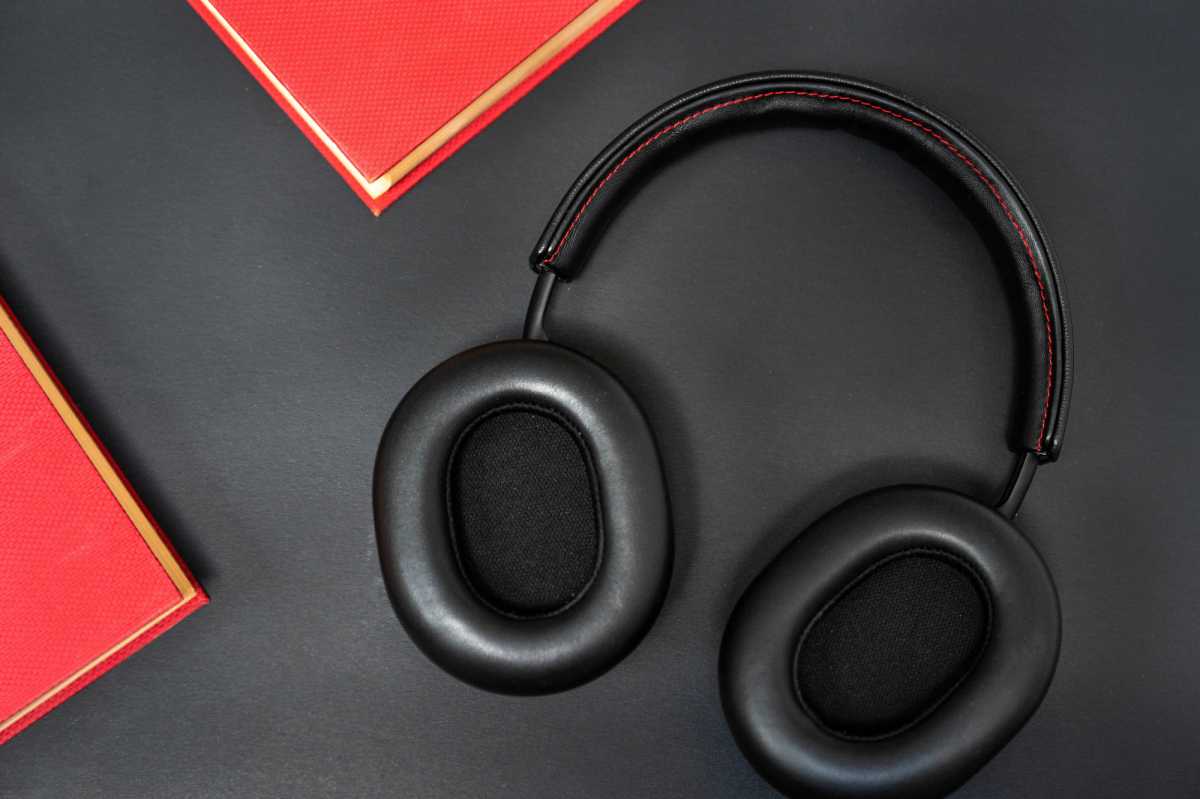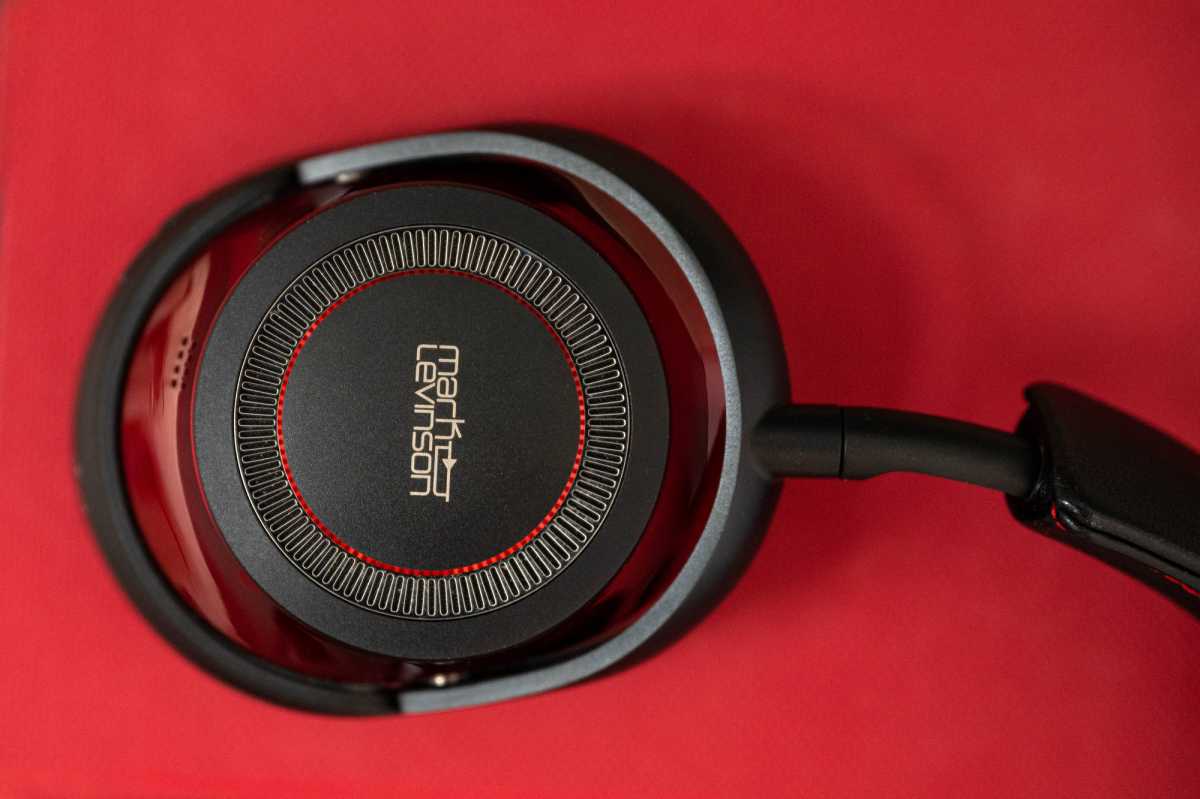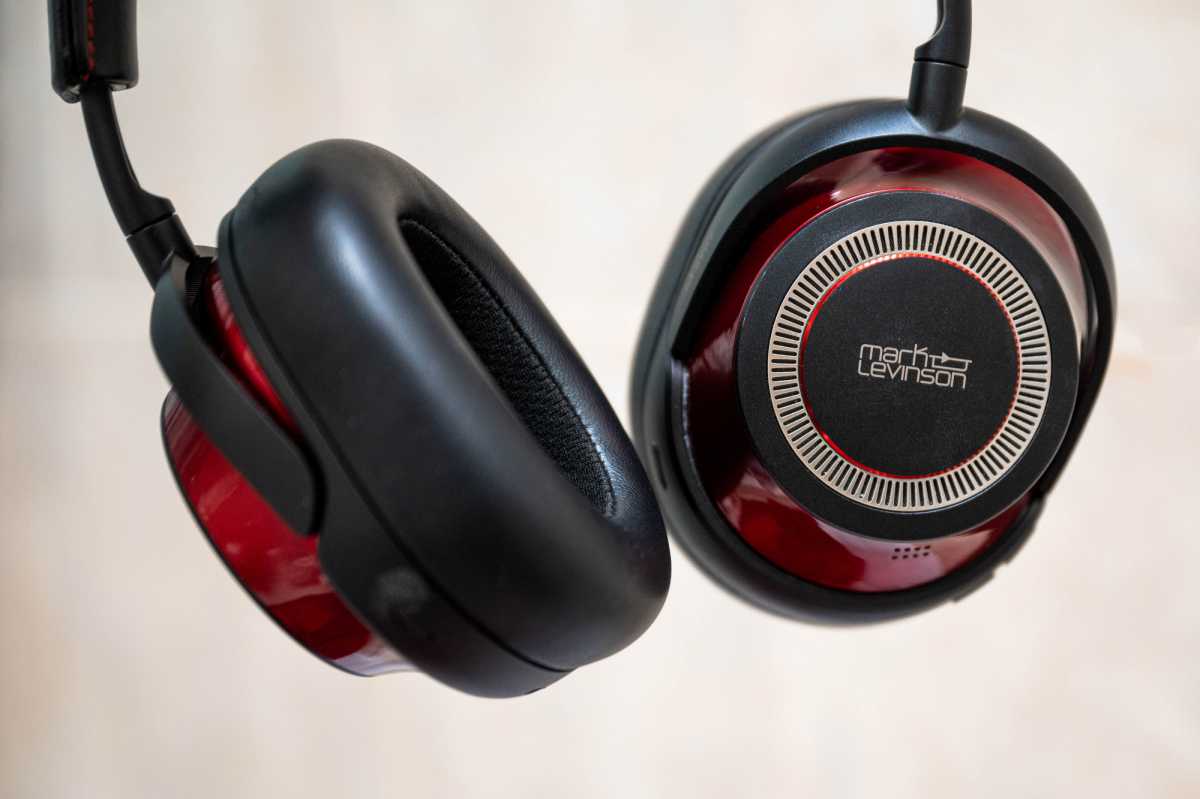At a glance
Expert’s Rating
Pros
- Best-in-class audio performance
- Excellent noise cancellation
- Premium materials and build quality
- Bluetooth 5.1 with support for LDAC, AptX Adaptive, and AAC codecs
- Three wired modes
Cons
- Noise cancelling can’t be engaged during phone calls
- Buggy on-head detection
- Run-of-the mill mobile app
- Very expensive
Our Verdict
This is a gorgeous headphone worthy of the Mark Levinson heritage, and it will exceed the sonic expectations of even the most demanding music lover.
Price When Reviewed
$999.00
Best Prices Today: Mark Levinson No. 5909 noise-cancelling headphone
Mark Levinson is to audio what Lamborghini, Porsche, and Ferrari are to automobiles. The high-end brand, named after its legendary founder, has left an indelible mark with audio products priced in the four and five figures.
The Mark Levinson team is looking to add a new—and admittedly atypical—product to that legacy: The $999 No. 5909 wireless noise-cancelling headphone. This is the first headphone model Mark Levinson has ever produced, and it’s designed for the busy professional or passionate listener.
What makes this headphone special isn’t necessarily its pedigree, premium materials, onboard tech, or noise-cancelling performance (though it has all of those, too). Rather, what’s notable is the No. 5909’s voicing to the so-called Harman target curve for headphones. The result? A gorgeous headphone worthy of the Levinson heritage that will exceed the sonic expectations of even the most demanding music lover.
This review is part of TechHive’s coverage of the best noise-cancelling headphones, where you’ll find reviews of the competition’s offerings, plus a buyer’s guide to the features you should consider when shopping for this type of product.
Mark Levinson No. 5909 industrial design
 The metallic paint job on the Mark Levinson No. 5909 is just what you’d expect to see on a luxury item such as this.
The metallic paint job on the Mark Levinson No. 5909 is just what you’d expect to see on a luxury item such as this.
Ephe Nicolakis
The unboxing experience, followed by the first time you pick up the No. 5909, seductively whispers luxury audio. The headphones come in three color options: Pearl black, ice pewter, and radiant red, the latter of which was the color of my review sample. Levinson fans will note that the color combinations are a direct nod to the classic Levinson color motifs. Mark Levinson audio gear is distinguished by its black and gray industrial design with red accents.
The No. 5909’s headband is wrapped in premium leather. The headband’s leather top side is rugged while the leather underside is incredibly soft and supple. While the padding doesn’t seem generous, I never felt that the headband exerted any unusual or uncomfortable pressure even after long listening sessions.
The matte black, anodized aluminum arms extend smoothly—there’s no cheap click-stop here. Best of all, the arms stay firmly in place.
The ear pads are likewise enveloped in soft leather. They were incredibly comfortable on my ears. As you’d expect in a luxury headphone, the leather ear pads are replaceable.
The ear cups are painted in a high-quality, automotive-grade metallic paint. The high gloss look of my radiant red review pair was simply gorgeous. The beveled edge of the Mark Levinson medallion on the ear cups is tinted red in a further nod to the brand’s visual design heritage.
The ear cups fold flat for easy storage and travel. At no time did I feel as though the headphones exerted unusual pressure around my ears.

The Mark Levinson No. 5909 ear cups fold flat for storage in their hardback travel case.
Ephe Nicolakis
The right ear cup houses the USB-C charging port and controls in a typical three-button array of volume up, play/pause, and volume down. The Levinson design team gave the play/pause button a slight bump, so you can distinguish it easily by feel and get your orientation for the volume buttons. The play/pause button has four additional functions. First, it doubles as the answer/end call function for a paired smartphone. Pressing it twice skips forward. Pressing it three times skips back. Pressing and holding the button activates the voice assistant on your smart device.
The left ear cup houses two buttons. The lower button powers up the headphones and the upper button toggles between passive, noise-cancelling, and ambient-aware modes. The ergonomics of the buttons are near perfect and conform to the natural orientation of your thumb on the ear cup.
The Mark Levinson No. 5909 comes with a generous collection of accessories, including a zippered, hardback carrying case emblazoned with the Mark Levinson logo. The hard case maintains its shape when empty and doesn’t fold flat like the one that comes with Sony’s WH-1000XM5. That means it does take up space in a backpack or suitcase when empty.
Both the case and the zipper are coated, seemingly to protect the headphones from an errant spill. Inside the case, there’s a zippered compartment with ample space for cables and accessories. You don’t need to worry about cables falling out or getting tangled in some pocket. It’s a minor but oh-so-great feature.
Speaking of cables, the Levinson come with a 1.25 meter USB-C-to-USB-C charging cable that does double duty as a digital connection to a computer for music playback. There are two USB-C-to-3.5mm cables for connecting to analog sources: a 4-meter cable and a 1.25-meter cable. The 4-meter cable is ideal for using the headphones with a headphone amp or other desktop source. Also included is a USB-C-to-USB-A adapter, a 1/8-to-1/4-inch adapter for connecting to headphone amplifiers, and an airplane audio adapter. A Mark Levinson-branded polishing cloth caps things off.

The Mark Levinson No. 5909 have a USB-C port for charging, but the headphone can also function as a USB audio device. A USB-C-to-3.5mm audio cable for connection to an analog audio source is also provided.
Ephe Nicolakis
Under the hood, the Mark Levinson No. 5909 feature Beryllium-coated (not pure Beryllium) drivers. The base material is PET (polyethylene terephthalate) that a Mark Levinson representative said is a strong, lightweight, shatterproof, recyclable, and highly sustainable material. The motor magnet material is neodymium.
Driver materials are incredibly important to a speaker or headphone’s performance. Beryllium is prized for its combination of lightness, rigidity, and superior pistonic performance. Beryllium drivers typically don’t have breakup in the audible frequency range. Mark Levinson’s high end loudspeaker sibling, Revel Speakers, reserves Beryllium for its top-of-the-line models.
Battery life is perfect for the executive road warrior. The Mark Levinson No. 5909 is rated to deliver up to 34 hours of playback time without ANC and up to 30 hours with ANC enabled. You can take a transatlantic or transpacific flight roundtrip without ever having to worry about charging the No. 5909. With their power-save feature enabled, I charged the Levinson headphones maybe once or twice a week—and that was using them extensively for video conferencing calls in addition to music and entertainment.
The Levinson sport four microphones in each ear cup (two for phone calls and two for active noise cancellation. You’ll have confidence taking or making calls. The No. 5909 come standard with Bluetooth 5.1. Connectivity with my iPhone 12 Pro (which sports Bluetooth 5.0) was outstanding. I could go 90 feet from my iPhone, including between floors, without missing a beat.
I did come across one annoying feature: If you’re making a phone call, the Levinson activate their ambient-aware mode and won’t allow you to switch to noise-cancellation or passive mode during the call. That’s fine in most cases, but if I took a call in a modestly noisy environment, such as an airport or the NYC streets, I found this function to be problematic as the outside noise battled with the caller’s voice.

The Mark Levinson No. 5909 is outfitted with microphones inside and outside of each ear cup, four for phone calls and four for active noise cancellation.
Ephe Nicolakis
Using the Mark Levinson No. 5909 wired and wireless
The Mark Levinson No. 5909 headphones feature Qualcomm’s QCC5124 DAC. The No. 5909 take no prisoners with their refreshingly thorough support of all modern hi-res streaming codecs. Sony’s LDAC hi-res audio codec is on board as is Qualcomm’s flagship aptX Adaptive, and Apple’s AAC. LDAC can stream up to 96kHz/24-bit audio at rates as high as 990Kbps over a Bluetooth connection. No matter your preferred streaming source, the Levinson will ensure you’ll get the optimum connection for the best possible sound.
There are three distinct wired modes, which is a unique feature of the No. 5909. The first is active analog audio mode, which works with the USB-C-to-3.5mm cable. It processes the audio signal through the No. 5909’s internal EQ and allows you to cycle through ANC and transparency modes. The headphones must be powered up before you plug in the cable to enable this mode.
The second mode is active USB digital audio. Starting with the headphone turned on, you use the USB-C-to-USB-C cable and listen digitally direct from your computer or digital source. The EQ will use the last setting in the Mark Levinson mobile app. The ANC button will cycle through the modes, and the headphone will charge its battery while you listen.
The third and final mode is pure passive analog. This delivers the widest frequency response, from 10Hz to 40kHz. Passive analog engages when the battery is dead, or when you plug in the USB-C-to-3.5mm cable with the headphones turned off. This bypasses all EQ, and the ANC toggle switch on the left ear cup will not work.
Onboard tech and the Mark Levinson app
High-end audio gear—Mark Levinson products in particular—typically eschew bells and whistles, flashy features, and anything that might taint the audio signal path. As a result, the Mark Levinson companion app has a Spartan feature set compared to some of its competitors. The app tells you the headphones’ current charge and gives you the option to select noise-cancelling or ambient-aware modes, set the auto-off timer, enable on-head detection, and perhaps most importantly, set the Harman target curve bass contour.
On-head detection, off by default in the app, proved to be buggy for me. When I enabled it, I found that music would had a tendency to pause, even though I was still wearing the headphones. I gave up on it and kept the feature off during my review period.
Mark Levinson No. 5909 noise-cancelling performance

The Mark Levinson No. 5909 were comfortable to wear for long listening sessions, even with the surprisingly thin padding on the headband.
Ephe Nicolakis
The No. 5909 sports three noise-cancelling modes: high, adaptive, and low. The high and low settings maintain a constant level of noise cancelling, while the adaptive mode automatically adjusts noise-cancelling intensity based on the level of noise in your outside environment.
I used the Mark Levinson No. 5909’s noise-cancelling features extensively over several months. I took the headphones with me on a cross-country flight from NY to LA as well as on the NY subway and Manhattan’s busy streets.
The No. 5909’s noise-cancelling prowess is strong and an able companion to the road warrior, although I would rank them behind Sony’s WH-1000XM5, which are simply the best noise-cancelling headphones I’ve reviewed to date.
What is the Harman target curve for headphones?
One of the main selling points of the Mark Levinson No. 5909 is their precision tuning against the Harman target curve for headphones. The Harman target curve is one of the reasons why the Levinson sound so good.
As recently as a decade ago, our understanding of listeners’ headphone preferences and the measurements that would best predict them were still in their infancy. That all changed thanks to Dr. Sean Olive and the world-renowned research team at Harman International. This is the same team whose pioneering research, led by Dr. Floyd Toole in the 1980s, gave us the definitive guide for the acoustics and psychoacoustics of loudspeakers, and Todd Welti’s subsequent research in the 2000s that determined the ideal number of subwoofers in a rectangular room and their optimal locations.
The headphone research led by Dr. Sean Olive over the past decade is what yielded the so-called “Harman target curve for headphones.” The company calls the Harman curve the “acoustic equivalent [of] a universally satisfying audio ‘recipe’ that a vast majority of listeners will enjoy.”
The Harman target curve is a sound curve that both trained and untrained listeners preferred for headphone listening. Perhaps unsurprisingly, this response curve closely resembles the in-room response of an accurate loudspeaker in a semi-reflective room, as shown from Dr. Toole’s research.
What’s perhaps most notable is that preference for the Harman target curve transcends age, geographic location, listener training, and gender. Dr. Olive’s research results further showed that 64 percent of listeners preferred the Harman target curve, while 21 percent (typically listeners over 50 or women with a preference for classical music) preferred the Harman target curve with less bass, and 15 percent (typically younger listeners who were fans rock and rap) with more bass.
Realizing that listeners fall into these sub-groups, the No. 5909 companion app allows you to alter the headphone’s target response to match the bass response preference in accordance with Harman’s research results.
Listening tests with the Mark Levinson No. 5909

The Mark Levinson No. 5909 exhibit first-rate build quality.
Ephe Nicolakis
I ran the gamut with various connection methods with the Mark Levinson No. 5909 headphones: An iPhone 12 Pro, a Fiio M9 hi-res DAP with LDAC, via USB-C to my 16-inch Intel MacBook Pro, and wired with my Monoprice Monolith desktop balanced headphone amplifier with THX AAA technology. My Roon Nucleus server, Tidal, and Apple Music provided the source material.
Let me cut to the chase: These are the best-sounding noise-cancelling headphones I’ve ever reviewed. You’ll put these headphones on and want to listen to your favorite songs all over again as though you’re experiencing them for the first time.
The Levinson’s penchant for rendering a dimensional soundstage is uncanny. Songs like Adele’s “River Lea,” Norah Jones “Don’t know why,” Katie Melua’s “If You Were a Sailboat,” and Michael Jackson’s “Smooth Criminal” broke free from the typical headphone incarceration. Listening to a song you’ve heard hundreds of times through the No. 5909 will make you feel as though you’re experiencing that song for the first time.
Vocals were pristine with near perfect timbral accuracy. Vocals were rendered with the clarity, detail, and the flat-out hair-raising purity that you’ll experience from a high-end loudspeaker. For example, Elaine Paige’s iconic rendition of “Memory,” from Cats, played through the No. 5909 was intimate, energetic, and intoxicating.
The refinement extends to instruments, which were placed firmly in space and time. There is no muddiness, smearing, or anything to get between you and the music. Notes come across with texture and detail that other noise-cancelling headphones can’t match. Discerning music lovers will relish being able to do a deep dive into the micro dynamics of their favorite music.
Songs like Imelda May’s “Call Me,” Birdy’s “Open Your Heart”, or Yo-Yo Ma’s rendition of Ennio Morricone’s “Dinner,” from Lady Caliph, through the No. 5909 delivered the songs’ intimacy and emotional energy.

You can purchase replacement memory foam ear cups for the Mark Levinson No. 5909 should they become damaged over time.
Ephe Nicolakis
The Levinson loved to play big and bold with orchestral works, such as Hungarian Rhapsody No. 2 in C-Sharp Minor, conducted by Leopold Stokowski, delivered the grand staging, transparency, detail, and dynamics that makes classical works shine.
Bass lines are authoritative, pistonic, and under absolute control. I played my typical repertoire of bass tests over and over, shaking my head in astonishment. The No. 5909 delivered the deep bass lines on Bonnie McKee’s “Trouble” and Lorde’s “Royals” with authority. Bass on Holly Cole’s “I can see clearly now” and the O-Zone Percussion Group’s “Jazz Variants” were ridiculously clean, textured, and delivered without any hint of bass bloat, all while keeping vocals and accompanying instruments clearly articulated.
The refinement and control you’ll find in the Mark Levinson No. 5909 allows the listener to move toward a deeper musical experience, appreciate the complexity of musical layers, and unfold more details in the music.
The best-sounding noise-cancelling headphones you can buy
If you’re looking for what is arguably the best-sounding noise-cancelling headphone on the market today, and aren’t intimidated by their $999 price tag, look no further than the Mark Levinson No. 5909. They are the pinnacle expression of the science of headphone sound.
These are luxurious headphones with premium build quality worthy of the Levinson heritage and will satisfy the most demanding music lover. A few functional quirks aside, if strong noise-cancelling performance and pristine sound are the top of your priorities, and you don’t care for extraneous bells and whistles, then the Mark Levinson No. 5909 deserve the top spot on your list.

